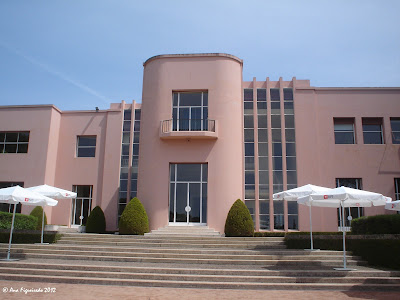I have lived for almost 18 years in the street of Serralves, therefore my childhood is strongly attached to those amazing gardens, where we could play and enjoy ourselves. By that time, we used to call it "Quinta do Conde de Vizela", which was not totally accurate, but it was good enough for people in the neighbourhood!
 |
| Credits: anacf3@gmail.com |
The history of Serralves House dates back to the start of the 1920s, after Carlos Alberto Cabral, 2nd Count of Vizelainherited the family’s summer residence. As a cultivated and well-travelled man, he was attracted to modernity and cosmopolitan living – aspects that did not rest easily with the social and cultural climate of the city of Porto, and which were partly due to the French and English education he received during his childhood.
In 1925, in order to acquire furniture for the new house, he travelled with the architect, José Marques da Silva to the International Exhibition of Modern Decorative and Industrial Arts in Paris. The modernity of the event fascinated him and he established contacts there with the famous decorator, Émile Jacques Ruhlmann.
Various people were involved in building the House, but its authorship may be attributed, with a certain degree of care, to Charles Siclis, who played a decisive role in the project’s global design and José Marques da Silva who developed, altered and executed the building.
The building – that should be viewed as a collective work – was only concluded in 1944, with a considerable delay due to the difficulties caused by the Spanish Civil War and the Second World War. It is considered to be the most notable example of an Art Deco building in Portugal, even though it was finally completed well after the end of the golden years of this style. The building is far more audacious than any other buildings in the context of Portuguese architecture at the time.
Accompanied by Blanche Daubin, with whom he was to marry in the early 1950s, the Count finally moved to the house in 1944. However he only lived there for a short period oftime. Due to financial difficulties, he ultimately sold it and the rest of the property to Delfim Ferreira, Count of Riba d’Ave, before moving to the top two floors of a building in Porto. However the sale agreement involved a key restriction - no transformations could be made to the property. In 1986, it was sold by Delfim Ferreira’s heirs to the Portuguese State.
Nowadays, the Serralves Foundation is a European cultural institution serving the national community, whose mission is to raise the general public's awareness concerning contemporary art and the environment. The Foundation pursues its mission via the Museum of Contemporary Art as a multi-disciplinary centre, the Park as a natural heritage site ideally suited for environmental education and entertainment activities and the Auditorium as a centre for reflection and debate on issues facing contemporary society.
 |
| Credits: anacf3@gmail.com |
Next weekend, Serralves is promoting for the 9th time a huge free-entrance festival - Serralves em Festa - and offering 40 hours of non-stop activities, with more than 240 events of theatre, puppets, exhibitions, guided visits, contemporary circus, photography, dance, cinema, music, performance and workshops -with activities for all ages.
Here you can check how last year's edition was amazing! Besides all the cultural events, the unique gardens, the landscape, the lake and the green all around you are incredible... Don't miss this opportunity!
I was there two years ago on that event, as well as last year!... That's a fantastic place!
ReplyDeleteIt really is, Sky!!!
ReplyDelete